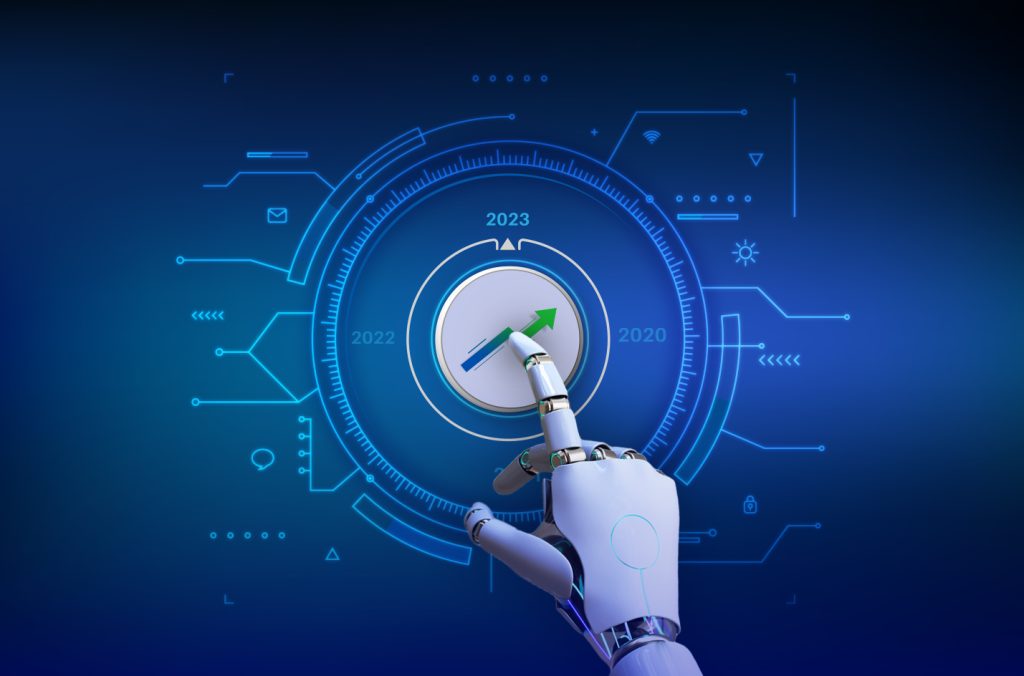
It is safe to say that 2023 is the year of artificial intelligence. Different types of AI models have taken the world by storm. 2023 wasn’t just another year in the evolution of AI. It was a leap year, a period of astonishing progress and extraordinary breakthroughs that portrayed AI’s potential to not only transform industries but to reshape our lives. From art generation to climate change mitigation, from revolutionizing healthcare to democratizing technology, artificial intelligence left its undeniable mark this year, leaving us deeply curious about the future it promises.
Democratization of Artificial Intelligence
Before discussing any of the significant milestones achieved by AI, we have to talk about the democratization of AI. This refers to how advanced AI models are now available to the public. This was not the case before. AI used to be the domain of tech giants, but today it is readily available to the public, which means AI is a tool in everyone’s inventory. This is the vision of the democratization of AI, a movement breaking down barriers and putting the power of this transformative technology into the hands of the people.
Platforms like Teachable Machine empowered individuals to train their own AI models, while cloud-based platforms like Amazon Quantum Challenger made quantum computing resources more accessible. From labs to living rooms, high-spec AI models are now available to everyone.
Generative AI: Making the Impossible Possible
It was a dream for people to create images or videos just from words. Now that dream is a reality, thanks to generative AI. Tools like OpenAI’s DALL-E 2 and Stability AI’s Stable Diffusion pushed the boundaries of creative expression, blurring the lines between reality and the digital canvas. These “dream machines” not only sparked artistic exploration but also found practical applications in fields like product design, architecture, and even medical visualization.
Human or LLM
Large Language Models, commonly known as LLMs, have completely changed the way we communicate with machines. LLMs are advanced artificial intelligence models designed to understand and generate human-like text based on the input they receive. LLMs are a subset of the broader field of Natural Language Processing (NLP) and have gained significant attention for their language understanding and generation capabilities.
LLMs are able to create text-based content by analyzing data using a process called deep learning. Deep learning is used to identify patterns and nuances in human language. This includes gaining an understanding of grammar, syntax, and context. Understanding context plays a huge role in the functioning of LLM.
OpenAI’s LLM, ChatGPT, led the AI race, proving to be far more powerful than anything else on the market at the time. It was so impressive that tech giant Microsoft coughed up a hefty 13 billion USD to invest in the company, ending up owning 49% of OpenAI. Today, sources estimate that the approximate value of OpenAI is 29 billion USD. This initiated the battle for the most powerful language model, with tech giants like Google, Baidu, and Meta throwing their hats into the ring with their own models like Bard, Lamda, etc.
Healthcare and AI
Advancing healthcare beyond the capabilities of humans has always been a goal when developing artificial intelligence. The healthcare industry has received a major boost thanks to the development of AI. These AI models are making concepts that were once thought to be impossible a reality.
DeepMind’s AlphaFold 2, a protein structure prediction tool, achieved near-perfect accuracy, paving the way for drug discovery and personalized medicine. With the ability to understand the intricate dance of molecules, AlphaFold 2 paves the way for faster development of targeted therapies and treatments for diseases like cancer and Alzheimer’s.
Another model, RETFound, is a model capable of identifying sight-threatening eye diseases. But its capabilities don’t stop there. The model can also predict general health risks, including heart attacks, strokes, and Parkinson’s disease. The models is able to do all this by just evaluating retinal scans.
These are just some of the AI models in the healthcare industry that prove integration of artificial intelligence in the healthcare industry would be massively beneficial. Especially for the patients.
Maximum Productivity at the Workplace
With the introduction of AI, people are now able to increase their creativity and productivity by streamlining their workflows. With mundane tasks taken care of, people now have the time to focus their expertise on more complicated tasks. Additionally, AI tools focused on increasing productivity have begun emerging. For example, Google Workspace integrated AI features into their platform like email assistant, document analysis, etc.
The Good, The Bad, and The Ethics
We have discussed how artificial intelligence is changing the world for the better. But when discussing the positive aspects of AI, it is important to discuss the negative side of it. Issues like job displacement, the use of AI in malicious ways, etc. When discussing AI, people rightfully express concern about job displacement. The thought of artificial intelligence stealing their jobs has always been a prominent talking point. That is why the goal of AI development should be to enhance human capabilities. This will bring forth a sense of collaboration between humans and technology.
This is why there should be strict laws passed to regulate the use of AI in workplaces.
A Glimpse of the Future: Where Do We Go From Here?
As we stand at the dawn of 2024, the promise of AI hangs heavy in the air. From personalized healthcare to immersive entertainment, the possibilities seem endless. The challenges, however, remain real. Issues like bias in algorithms, the potential for job displacement, and the need for clear ethical frameworks continue to demand our attention.
So, where do we go from here? 2023 has shown us that the potential of AI is boundless, but also that its responsible development and application are crucial. As we move forward, let us experience the opportunities AI presents with open minds and open hearts, ensuring that this powerful technology serves as a force for good, illuminating the path towards a brighter future for all.